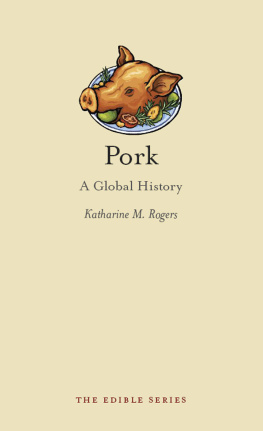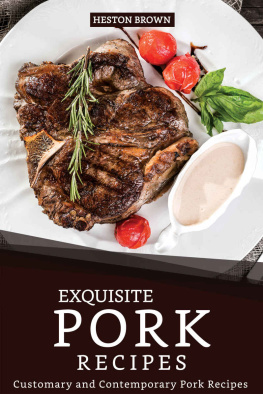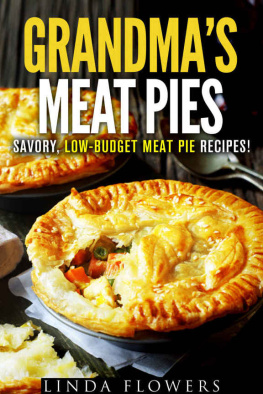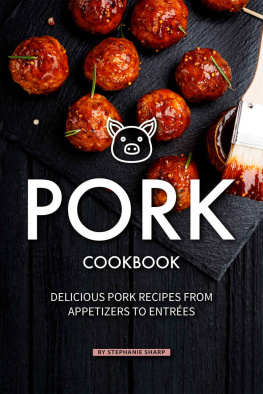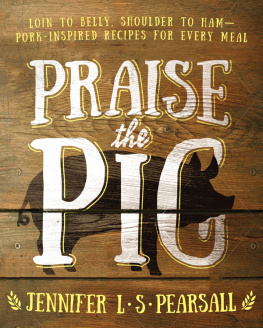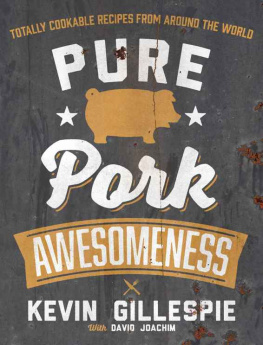PORK

Edible
Series Editor: Andrew F. Smith
EDIBLE is a revolutionary new series of books dedicated to food and drink that explores the rich history of cuisine. Each book reveals the global history and culture of one type of food or beverage.
Already published
Apple Erika Janik | Lemon Toby Sonneman |
Bread William Rubel | Lobster Elisabeth Townsend |
Cake Nicola Humble | Milk Hannah Velten |
Caviar Nichola Fletcher | Olive Fabrizia Lanza |
Champagne Becky Sue Epstein | Pancake Ken Albala |
Cheese Andrew Dalby | Pie Janet Clarkson |
Chocolate Sarah Moss and
Alexander Badenoch | Pizza Carol Helstosky
Potato Andrew F. Smith |
Cocktails Joseph M. Carlin | Pudding Jeri Quinzio |
Curry Colleen Taylor Sen | Rum Richard Foss |
Dates Nawal Nasrallah | Sandwich Bee Wilson |
Gin Lesley Jacobs Solmonson | Soup Janet Clarkson |
Hamburger Andrew F. Smith | Spices Fred Czarra |
Herbs Gary Allen | Tea Helen Saberi |
Hot Dog Bruce Kraig | Vodka Patricia Herlihy |
Ice Cream Laura B. Weiss | Whiskey Kevin R. Kosar |
Pork
A Global History
Katharine M. Rogers
REAKTION BOOKS
Published by Reaktion Books Ltd
33 Great Sutton Street
London EC1V 0DX, UK
www.reaktionbooks.co.uk
First published 2012
Copyright Katharine M. Rogers 2012
All rights reserved
No part of this publication may be reproduced, stored in a retrieval system, or transmitted, in any form or by any means, electronic, mechanical, photocopying, recording or otherwise, without the prior permission of the publishers.
Page references in the Photo Acknowledgements and
Index match the printed edition of this book.
Printed and bound in China by Eurasia
British Library Cataloguing in Publication Data
Rogers, Katharine M.
Pork : a global history. (Edible)
1. Pork. 2. Cooking (Pork) History. 3. Cooking (Pork)
I. Title II. Series
64I.364-DC23
eISBN: 9781780230627
Contents

1
The Ideal Meat Producer

About 7,000 years ago, people in the Near East and perhaps also in China domesticated Sus scrofa, the Eurasian wild boar. Since then, pigs have provided the most widely eaten meat in the world. Pork is the most versatile of meats ranging from the rich, delicate succulence of a roast loin to the dry, salty assertiveness of ham and bacon. Charles Lamb celebrated the delights of roast suckling pig, particularly its crisp skin, in his Dissertation on Upon Roast Pig (1823): Crisp, tawny, well-watched, not over-roasted, crackling offers the pleasure of overcoming the coy, brittle resistance of browned skin together with the indefinable sweetness of the meltingly tender fat layer underneath, the cream and quintessence of the child-pigs yet pure food fat and lean so blended and running into each other, that both together make but one ambrosian result, or common substance. Sara Perry could rely on general agreement when she titled a cookbook Everything Tastes Better with Bacon.

John Frederick Herring Sr (17951865), A Family of Pigs, oil on canvas.
Although a roast suckling pig is the most luxurious form of pork, almost every part of a pig is edible, including its blood (black pudding) and tail (flavouring for soups and stews). Jane Grigson, writing in 1967, deplored the distaste of the English for the less obviously promising parts of a pig, and expanded on what could be done:
The skilful and economical housewife can buy a pigs head for 3/or 4/; this is what she can make from it pigs ears with a piquant sauce brains in puff pastry Bath chap [the cheek, cured, smoked, and simmered something like a small ham] 1 pounds of sausage meat for making pt or [sausages] There is an average of 4 pounds of boneless meat on a pigs head. And an excellent clear soup or aspic jelly is to be made of the bones.
Even pigs bladder can be highly desirable. Guinea-hen-in-pig-bladder was a popular dish at a two-Michelin-star restaurant in Las Vegas until the authorities forced them to remove it because they were getting the bladders from an unapproved source. So far they have been unable to locate an approved one, because American meat packers routinely grind up the bladders for dog food.
Pig fat lard was for centuries the most common fat for frying and for shortening cakes and pastry in northern Europe and America. It was rendered at home and could be kept for many months in the cool, aptly named larder. It is less used now, because of the availability of butter and oil and our awareness of the dangers of saturated fat, in which lard is particularly rich. Lard was also used as a preservative: covering meat with a layer of lard kept it from contact with the air. When some meat was needed, the fat was melted, the necessary meat taken out, and the crock replaced in a cool larder to re-solidify.
Pork should be greyish pink and covered with a layer of firm white fat; it is the fat that makes it so tasty and succulent. Nevertheless, mindful of current concerns about health, American and European breeders are now producing leaner pigs. They now average 16 per cent leaner with 27 per cent less saturated fat than they had nineteen years ago. The United States National Pork Board is calling pork the other white meat in hopes of persuading people to see it as a low-fat and low-cholesterol alternative to turkey and chicken. The Board has found a study that shows pork supports weight loss goals, as well as being full of minerals and vitamins. On the other hand, many Chinese and other cooks deplore this sacrifice of flavour to a healthful diet.

German schmalz or lard.
Salting, drying and smoking were invented in order to preserve meat in the days before refrigeration, when it was essential to find a way to make use of all of an animals meat long after it had been slaughtered. Salt draws water out of meat cells, and dehydration kills bacteria or inhibits them from multiplying. Smoking helps the slow drying process and gives additional flavour. In the case of pork, more than other meats, these processes create products that are delicious in their own right. Not only does the high fat content of pork allow it to retain some succulence even after smoking, but drying and smoking might be said to improve pork by firming its texture and intensifying its flavour. Corned or jerked beef are not nearly so flavoursome as bacon, ham or cured sausage.

